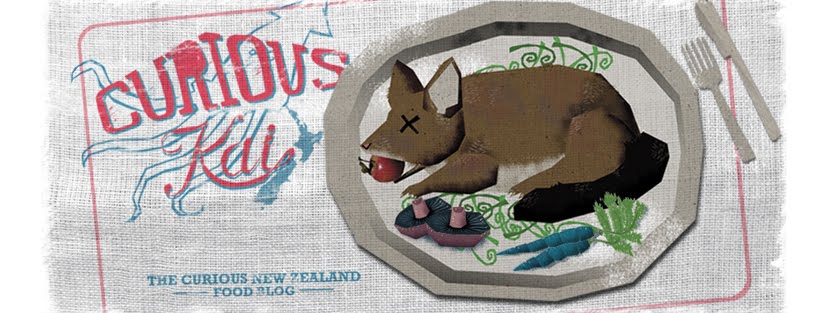I recently made a wholemeal rewena loaf, promptly forgot about it, and then re-discovered it several days later in all its stale, dried out, brick-like glory. It seemed a waste to feed it to the birds (and given its state, chances are they'd only pick it up & drop it back off on my doorstep), so I thought I'd give that classic English dessert, brown bread ice cream, a try.
As you can see from the slices I managed to hack off, it was a good sourdough, probably my most successful yet. It was forgotten in my rush to get back to my mum's for Christmas, so it spent a few days doing some additional baking in the afternoon summer sun that streams in through my kitchen window. The bread looks a little pale in the photo, but it was a lovely brown colour. It's now gone to a better place...
Brown Bread Ice Cream
4 egg yolks
100g caster sugar
vanilla pod
375ml milk
125ml cream
40g butter
100g crustless wholemeal bread, stale
50g soft light brown sugar
300ml cream
1 tablespoon brandy (optional, but it does lend a nice flavour, and the alcohol will make the ice cream nice and smooth)
Preheat your oven to 180c. Place your stale bread in the food processor to make crumbs (not too long, otherwise you'll end up with dust). Mix the brown sugar with the melted butter and add the crumbs, stir well then spread the mixture out onto an oven tray lined with baking paper.
Bake the crumbs for 15 minutes, turning from time to time until they are evenly toasted and crisp. Do keep an eye on them after the 10 minute mark, because depending on the idiosyncratic nature of your oven, they may burn. Once done, remove and leave to cool.
Cut the vanilla pod open and scrape out the seeds. Pour the milk into a pot, add the vanilla pod and seeds and bring to the boil.
While the milk is coming to the boil, whisk the egg yolks & sugar in a bowl until thick and pale. Gradually pour on the hot milk, whisking constantly. Return the mixture to the pot and cook over a gentle heat, stirring all the time - do not allow to come to the boil. When the custard thickens and coats the back of the spoon, pass through a sieve, add the brandy and leave to cool. Pop a piece of clingfilm directly on top of the custard to prevent it from forming a skin.
Stir the cream into the custard and place in your ice cream maker. Churn until thick, about 15-20 minutes. While that's happening, rub the breadcrumbs between your fingers to break up any big lumps. Add the crumbs into the mixture, a little at a time, and churn for an additional 5-10 minutes. Freeze, or eat straight away. How does it taste? Sweet, and pleasantly nutty and crunchy.
Note: there are doubtlessly a sizable number of you who don't have an ice cream maker. Here's a link to Jules of the fantastic Stone Soup who has a no-machine recipe for a lemon ice cream which could be adapted. The key to its success lies in the sugar content and amount of air incorporated into the mix. Also, David Lebovitz, world-renown pastry chef and author, has a recipe here for a no-machine ice cream.



Yesssssssss!
ReplyDeleteAwesome! I will definitely have to give this a go. Sure looks worthy of letting bread go stale, on purpose.
ReplyDeleteBtw, David Lebovitz's tips work really well. My end products have always turned out great. That said, I haven't been able to compare my ice creams/sherbets to machine-made versions. One thing I have to do different though is I beat at 15 minute intervals, as opposed to 30 (things crystallise way too fast). I guess every freezer is different so it kinda pays to 'baby sit' your mixture at first.
Thanks for sharing the great recipe!
Ciao Nigel
ReplyDeletemaybe you would like this:
http://alessandra-onlyrecipes.blogspot.com/2011/01/fresh-pasta-with-leaves-and-flowers.html
XX
A.
that actually sounds worth making another bug for! actually i still have some frozen bug i could ressurect - oh the irony to unfreeze it only to freeze it again. but i gave away my icecream maker in frustration so will have to investigate other methods to churn. As an aside, what does passing through a sieve do - do you just mean a regular metal sieve or a cloth one?
ReplyDeleteHi Lou! The sieve isn't essential; it's just to catch any bits, like tiny pieces of white or chalaza that may have ended up in the anglaise. Either kind (muslin or a metal sieve) will do.
ReplyDeleteAlessandra - That's fricken amazing! Pasta as art, & tasty too!
ReplyDeleteLinno - I think you're spot on; the 30 minute interval seems a bit too long a period of time to leave it before beating. Frequent beatings are a good idea anyway, whether it's ice cream, sorbets or children.